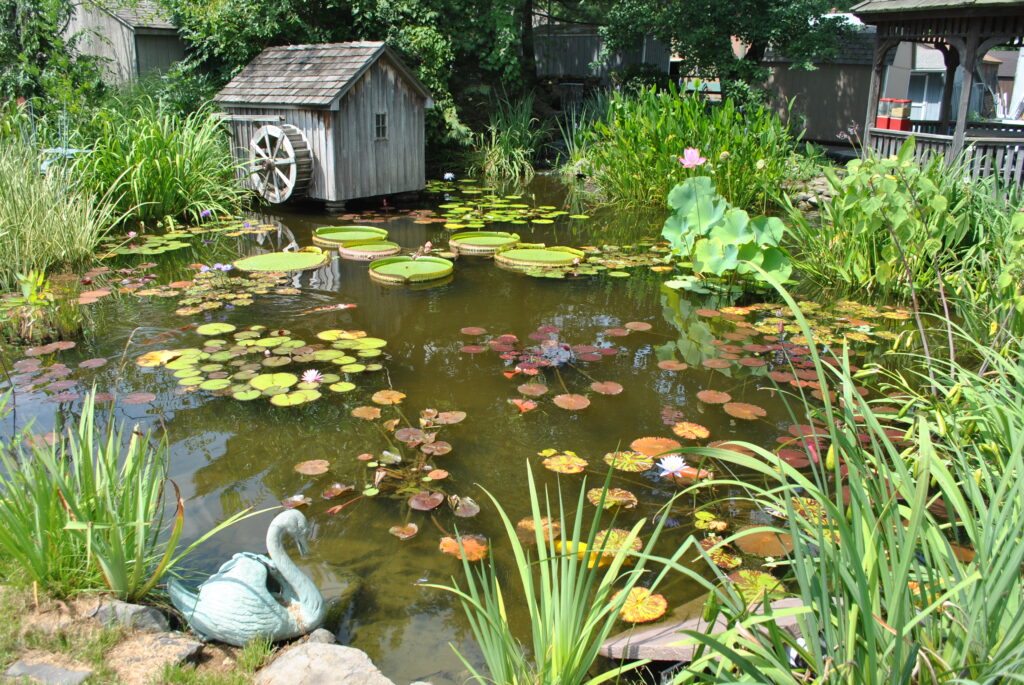
How to winterize aquatic plants is a very commonly sought after piece of information for water garden pond keepers. Everyone knows the internet is invaluable for fast how-to information and advice; however there is as much bad advice out there as there is good advice. The best advice will come from those who are professionals in the industry who have practical, first person, hands-on EXPERIENCE.
Yet, even the experienced can hand out some bad advice. When getting started in this industry, and to this day, I sought and seek out advice for just about everything in the world of water gardening. Because I live in an area that gets some pretty extreme weather with below freezing temperatures at times, the aquatic plants that I deal with need some preparation for those tough winter months. The early on advice that I was given for winterizing aquatic plants was to toss out the floaters and tropicals, then take all the hardy aquatic plants and sink them down to the deepest part of the pond for the winter. Come Spring, pull the plants out and place them back into the shallow water for the warm weather months. This is still commonly handed out advice; I hear it all the time from garden center and internet advisors.
This advice seemed to make sense to me at the time, and to this day I still toss the floaters like water lettuce into the compost pile; however I try to save larger tropicals like taro, if I can . The biggest difference is how I treat the hardy aquatic plants. My method has been very successful for many years and practiced on hundreds of ponds. Wanna know my advice on how to winterize your hardy aquatic plants? Well, here it is.
LEAVE THEM ALONE FOR THOSE TOUGH WINTER MONTHS
AND DON’T DROWN THEM!!
Might seem radical, but it works. I don’t mean to say don’t give them any care or preparation for the winter, but don’t drown them either! Yes, I said and mean drown. You can drown a plant, even an aquatic plant. I’ll explain why I say this after I share with you a quick run down on how I winterize the hardy aquatic plants that I deal with. My advice is assuming that your plants are doing well in your pond to begin with, and have been properly installed at the appropriate water level for each type of plant.
To winterize hardy water lily I remove the leaves, spent flowers, and stems right down to the crown of the plant. I don’t remove any submerged developing leaves or flowers. I do like to leave a couple of the best looking floating leaves to die off on their own, ..just my habit. Otherwise, that is it for the water lily. For the marginal plants like watercress and parrot feather, I cut all growth down to the crown leaving about an inch or two of healthy stems. For marginals like iris and pickerel I cut back leaves and stems to about 6” above the crown of the plant which should be at right about water level. THAT’S IT. Oh, and I do not fertilize any plants at this time. If the hardy aquatic plants that I am dealing with were doing well in their locations all season I do not move them. I do not sink them to the bottom of the pond!
Here is my thought process on this advice I am giving out. First of all, I know it works well because I have been practicing this for many years and see first hand the results; and if it did not work I’d change my approach. But here are my thoughts on why. If we are dealing with hardy aquatic marginal plants we are dealing with plants that are accustomed, acclimated, evolved, and genetically programmed to deal with extreme weather conditions of baking sun, and frozen winters at water’s edge. Water’s edge is a pretty extreme environment in the best of conditions. Marginals can deal with complete immersion for a period of time and can deal with fairly dry conditions for a period of time, for the majority of the time they live at water’s edge with their crown nice and wet just above or below water but never submerged for long, nor dry for long; and subject to ice and snow cover.
If nature has equipped them with the ability to live and thrive in these conditions, then why do we place them completely below water often in 2’ to 3’ of water! In other words flood conditions. We are drowning our plants for months at a time, and if our plants recover from this extended extreme condition of complete submersion at all; they certainly do not thrive the next season, or recover quickly. Probably within 2 seasons of this treatment they end up killed off. Think about where these plants come from in nature, these plants are pretty damn tough; however, if you drown them for 4-5 months a year even these water garden aquatic warriors will not make it back. It’s kinda sad.
So if you live in an area where weather conditions can get pretty cold and you have been following the practice of submerging your marginal plants for the winter months; I encourage you to give my method a try. I think you will be pleased with the “non-submersion” method of winterizing you hardy aquatic marginal plants. And hey, it’s easier than the submersion method and really allows your plants to establish and mature in your pond instead of getting literally ripped out of place each year; stressing your plants out and slowing its overall growth and development potential. Come spring it is easier to get things rolling in your pond too, and you’ll notice earlier development and growth. Trust your aquatic plants; they have been at this whole water garden thing a lot longer than we have!
Is there a method for winterizing aquatic plants that you want to share? Please let me know and post a comment for all the readers. Thanks for checking out the blog and see you next time. Visit www.facebook.com/loveyourpond to participate in our social media page too!
Here are some other pond winterization links to check out:
https://fullserviceaquatics.com/pond-fish/winter-pond-wisdom/
https://fullserviceaquatics.com/winterization/how-to-winterize-a-water-garden/
https://fullserviceaquatics.com/pond-fish/what-happens-to-pond-fish-in-winter/
Check out this video on Winter Pond Care from The Pond Hunter video series on YouTube:
Mike Gannon is owner at Full Service Aquatics located in New Jersey, USA. Being “In The Pursuit Of All Things Aquatic” has led Mike to be a lifelong hobbyist and fish enthusiast. Mike began working professionally in the aquarium and pond industry in 1990. Full Service Aquatics started in 1995 offering all services, design, and installations of koi ponds, water gardens, and aquariums. Since that time Full Service Aquatics has become recognized for their designer pond installations, featured in publications, and winning awards within the water garden and pond industry. Mike is the creator of THE POND HUNTER video series on YouTube, the LOVEYOURPOND page on Facebook, and the LOVEYOURPOND Blog. Mike’s website www.loveyourpond.com is dedicated to koi ponds, water gardens, natural ponds, other aquatic interests. The website features a gallery of beautiful pond images and a comprehensive FAQ section. To contact Mike visit his website www.loveyourpond.com or email him directly at mgannon@fullserviceaquatics.com
Other links for Mike Gannon:
www.facebook.com/thepondhunter
All copyrights to this material is solely owned by Mike Gannon.
